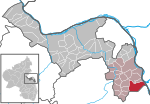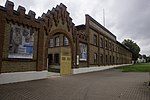The Osthofen concentration camp (German: KZ Osthofen) was an early Nazi concentration camp in Osthofen, close to Worms, Germany. It was established in March 1933 in a former paper factory. The camp was administered by the People's State of Hesse's Political Police, with guards first drawn from SA and SS, later only SS men. The first prisoners were mostly Communists or Social Democrats, but later Jehovah's Witnesses, Seventh-Day Adventists and non-political Jews were also sent to the camp.
Usually, Osthofen held 200 people at a time, with a total of about 3,000 prisoners over the existence of the camp. While none of the inmates died in the camp, many became sick due to the poor living conditions and hygiene. Abuse and humiliation of the prisoners, who were used as unpaid labourers, was common. One of the two prisoners who managed to escape from Osthofen, Max Tschornicki, met the author Anna Seghers in her Paris exile, and her novel The Seventh Cross, describes the conditions at a fictional "Westhofen concentration camp", inspired by Osthofen.
The site of the concentration camp was used as a furniture factory from 1936 to 1976, and the first plaque commemorating the existence of the camp was not installed until 1978. After activist pressure, the camp site was registered as a protected monument in 1989 and eventually turned into a memorial for the concentration camp by the state of Rhineland-Palatinate.










